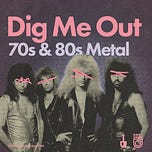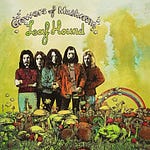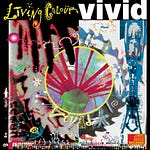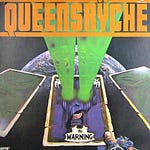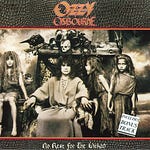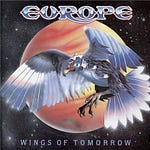Meet Our Expert Panel
We're absolutely stoked to have two incredible guests joining J, Tim, and Chip —each bringing their own unique lens to the glam metal conversation.
James Barber comes at this from the industry trenches. As a former A&R executive at Geffen Records, James worked with everyone from Lisa Loeb to Guns N' Roses, giving him an insider's perspective on how these bands actually got signed, developed, and marketed. But here's the cool part—while he was out on the road with his alternative rock friends in the 80s, he had a "secret affair" with glam metal that he's finally ready to talk about openly. James channels that passion into his Substack Stars After Stars After Stars, where he digs into music industry stories and audio history. And get this—he just curated the epic 57-track box set Young & Wild: A Decade of American Glam Metal 1982-1992 for Cherry Red Records, essentially creating the definitive education for Europeans who "don't know much about glam metal in America." The guy's basically the archivist we never knew we needed.
Alex Williams brings the most fascinating perspective of all—he's a country artist who just refuses to let these songs die. Born in '91 (so he missed the party the first time around), Alex grew up raiding his dad's wooden crate of CDs and fell hard for the genre. Instead of just being nostalgic about it, he's doing something radical: he's stripping these anthems down to their bones and rebuilding them as outlaw country songs on his forthcoming album Space Brain. Think "Round and Round" meets honky-tonk, or Ozzy filtered through rust-belt twang. It's proof that underneath all the hairspray and pyrotechnics, these were just incredibly well-written songs that can work in any genre if you know what you're doing.
The Great Hair Metal Debate
The 80s glam metal scene wasn't just about big hair and bigger hooks—it was a wild, genre-bending party that changed the face of rock, for better and for worse. And if you think you've heard it all, buckle up—because the truth is way messier, and a lot more fun, than the stereotypes let on.
The term "hair metal" wasn't even a thing back in the day—it was press-invented putdown that didn't surface until the early 90s. When these bands were ruling MTV and selling out arenas, fans just called it "metal", “glam metal” or "hard rock." The bands themselves were too busy raiding their girlfriends' closets for tight jeans and perfecting their gang shouts to care about labels.
The Roots Run Deeper Than You Think
Let's start at the roots. Glam metal (or "hair metal," depending on your age) was more than just a sound—it was a look, a vibe, a lifestyle. Think neon spandex, gang vocals, and choruses sticky enough to survive a nuclear blast. But it wasn't all party anthems and eyeliner. As James Barber, the guy behind the new "Young and Wild: A Decade of American Glam Metal" box set, put it, these bands were the garage rockers of their era—kids inspired by Kiss and Van Halen, but also by the glammy weirdness of T. Rex and Slade. "Kiss was the Beatles for this generation and Van Halen was the Stones," Barber said. That's a pretty wild family tree, right?
But here's a twist: glam wasn't really big in America during the 70s. The bands that all these metal kids knew and had listened to a thousand times—Sweet, T. Rex—had some random hit singles, but it wasn't a cultural wave here like it was in the UK. The kids who formed these bands were the cool kids who knew about the weird stuff from England that all their friends didn't know about. Guys like Nikki Sixx wanted to bring this music they grew up with—that was a secret for them—and share it with everybody else.
What Made Glam Metal Actually Glam Metal?
So what made glam metal special? It's all about the hooks, baby. Big, fat choruses, harmony vocals, and that "party rock" spirit. These weren't angry, testosterone-fueled thrashers—these were bands that wanted everyone at the show, men and women alike, to have a good time. "Nothing But a Good Time" wasn't just a song—it was the mission statement.
The Visual Revolution
The look was everything. Unlike their heavier metal cousins, glam bands prioritized image as much as sound. This usually meant long hair, big hair, bands playing with makeup and dressing up kind of like women, wearing strange clothing and creating their own outfits and costumes that were very visual. The androgynous aesthetic, borrowed from 70s glam rock pioneers like David Bowie and T. Rex, became weaponized for the MTV generation.
The Sound That Conquered MTV
Musically, what separated glam metal from generic hard rock was those big fat hooks, harmony vocals on the chorus, and lots of gang vocals. But it was definitely hooky enough that some metal kids from the 80s would say this wasn't metal at all because it was too hooky, too accessible to really be about pure testosterone and aggression.
The East Coast vs. West Coast Divide
Even within the genre, there were distinct regional flavors. The East Coast bands—Skid Row, Cinderella—were rougher around the edges, a little bit darker. They weren't all bleach blonde guys. Spread Eagle, for instance, looked like guys you'd cross the street to avoid because they might want to fight you. Meanwhile, the West Coast bands like Poison, Ratt, and Warrant leaned into the neon party vibe, prioritizing visual spectacle and accessibility.
The Media Machine That Built an Empire
It's hard to overstate the importance of Metal Edge magazine and MTV's Headbangers Ball in creating a full ecosystem for these bands. MTV gave you the most popular commercial version during daytime rotation, Headbangers Ball provided the grittier, not-quite-mainstream acts for dedicated fans, and Metal Edge delivered the unsigned bands and the behind-the-scenes lifestyle. Metal Edge sold the complete mystique—giving you the full picture from garage bands to Bon Jovi dominating MTV all day, every day.
The Albums That Still Rip
When pressed to name the definitive glam metal records that still hold up today, the experts had strong opinions. James Barber picked the first Faster Pussycat album as "the peak of the genre, the purest representation of the scene in L.A." The imaging, the vibe, the songs—it captured everything without being too sugary, just sugary enough.
For those wanting to understand the genre's essence, Cinderella's "Night Songs" provides a perfect entry point. You get the image on the cover, arena rock drums and gang vocals from 70s glam, ACDC-style riffs and vocals, guitar hero solos, and a power ballad to show you what that format looked like. Every song on that record is killer.
But perhaps the most honest assessment comes from Poison's "Open Up and Say Ah," which contains both the mission statement of 80s glam metal in "Nothing But a Good Time" and one of the definitive power ballads in "Every Rose Has Its Thorn". As one Tim put it, this captures the entire glam metal experience in one package.
The Party Atmosphere That Defined a Generation
This was party rock, pure and simple. When you went to these shows, it wasn't about metal's typical anger and aggression—it was literally a party. These shows had 50% women, and you were there to do drugs, hook up, and have a communal experience. People got along, they weren't fighting or punching each other in mosh pits. This was "hey, we're gonna go to a party together and this band's hosting it".
The party rock genre peaked and died with this glam metal scene. When alternative rock came in during the early 90s, it didn't just kill the visual aspect—it killed the idea that rock and roll could be a party. Through the 90s, rock became about mosh pits and angry young men blowing off steam, with fewer women attending shows.
The Downfall: When the Formula Became the Problem
But every party has to end, right? The downfall of glam metal wasn't just about grunge swooping in with flannel and frowns. The genre's own success—especially the endless parade of power ballads—became its undoing. Power ballads were "the heroin for record companies," as James put it. Once labels got that first hit of a top-five power ballad, they wanted every band to have one on their record.
Record labels started bringing in outside songwriters and sawing off the rough edges that made the early records special. By 1988, 1989, 1990, you had records where the lead single was the ballad, and these bands started losing credibility with their audience.
The industry became too formulaic. You could watch Headbangers Ball for an hour in 1989 and hear the same drummer on every song, even if the person on screen wasn't the person who actually played the drums. It became a studio genre as much about producers making records as the artists themselves.
As many from the scene will tell you: "It wasn't grunge that killed glam metal—it was glam metal that killed glam metal". The genre became a victim of its own success, churning out copycat bands with ever-sappier singles until even diehard fans started tuning out.
The Modern Legacy: Where Did All the Guitar Heroes Go?
The legacy lingers in unexpected places. You can hear glam's DNA in modern pop country (which some argue is the glam metal of today), in the tongue-in-cheek antics of Steel Panther, and in the arena-sized hooks of bands like Ghost. But there hasn't been a true resurgence like other genres have experienced. Unlike grunge or power pop punk, which have seen new waves of bands embracing those sounds, glam metal requires too much investment—the high-caliber songwriting, technically competent players, great singers, strong stage presence, and coordinated image. You can't just do that in your bedroom with GarageBand.
For every "Cherry Pie" that makes you cringe, there's a "Night Songs" or a "Faster Pussycat" debut that still rips as hard as it did in '87. The songs that worked still work because underneath all the hairspray and theatrics were genuinely skilled musicians who understood that the best way to move people is with an undeniable hook wrapped in larger-than-life personality.
The glam metal scene created a template for rock stardom that persists in pop culture today—the devil horns, the teased hair, the over-the-top stage clothes. When someone wants to play "rock star" in a movie or TV show, they're basically cosplaying a glam metal musician from 1987.
So crank up the volume, dig out your old Metal Edge magazines, and check out the latest Dig Me Out episode for the real story behind the glam, the grit, and the glorious excess of 80s metal. Why wasn't this band huge? Why did that one flame out? Let's argue about it together.
Songs in this Episode
Intro - Cherry Pie (Warrant)
3:50 - Round and Round (Alex Williams / RATT)
21:19 - Youth Gone Wild (Skid Row)
22:58 - Cry Tough (Poison)
41:12 - Bathroom Wall (Faster Pussycat)
42:19 - Looks That Kill (Motley Crue)
45:13 - Down Boys (Warrant)
47:22 - Somebody Save Me (Cinderella)
49:40 - Nothing But a Good Time (Poison)
1:11:03 - Wild Side (Alex Williams / Motley Crue)
Outro - Seventeen (Winger)
Metal Albums of 1985 | Roundtable Discussion
Close your eyes and step into 1985. The neon glow of arcade screens flickers off denim-clad kids pumping quarters into Punch-Out!! while the airwaves are drenched in the era’s defining paradox: a sonic tug-of-war between glammed-up, radio-friendly hooks and the rise of something darker, meaner, and more aggressive. It’s a world where


